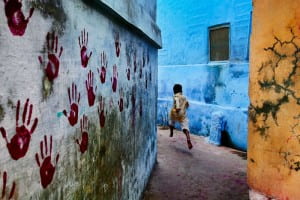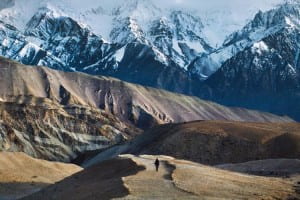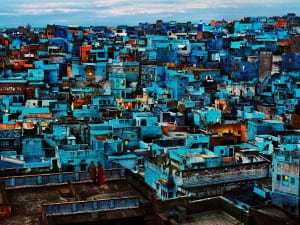Previous to seeing the exhibit, I had exposure to Steve McCurry’s work through the Internet. Quite frankly, I’m not drawn to his style. With a lot of his images on a screen, the colors are saturated, high contrast, and seem quite one-dimensional. The stark contrast and vivid bright colors seem like he uploaded the photos into Photoshop and played with the levels.
One example of this, in a photo I do not find to be successful, is the photo of a “Boy in Mid-flight”. The little boy is captured in “the decisive moment” as he flies through the passageway. For me, the colors don’t seem natural – distorted in a way, like when you put too many effects onto an image. It distracts from the imagery and there is too much visual information that nothing truly stands out.
However, in the case of his landscape photography, I found that looking at them in the exhibit at such a grandiose scale was empowering and engulfing. In the examples of “Blue City” and “Man Walks in the Himalayas”, the scene was so captivating and beautiful that I found myself wondering if this was truly how it looked or he had edited the photos to make them more impactful, perhaps by layering images or tinkering with colors in certain areas.
Either way, I was overwhelmed by how beautiful and masterful these landscape photos were. I literally had to get up close and personal to the photograph in order to check if it was a painting or not. The color makes the places seem otherworldly, ethereal, and gives it an overall positive vibe. In fact, most of his images seemed to focus on positive and communal aspects of India, which is quite the shift from some of the darker imagery we’ve been exploring (figuratively and literally).
I was not sure of the statement he was making by the end of the exhibit in the slightest. I did not feel as though there was a coherent theme or story he was trying to tell. Since he broke the exhibit into clusters depending on the cities the photographs were taken in, there is clearly an importance that had to do with the geographic location. However, I was unsure if he wanted to distinguish between each of the cities or create a cohesive narrative throughout. A blurb on the wall reads that the photographs “represent glimpses of everyday life in urban and rural areas, historical sites, splendid landscapes, and portraits of people McCurry encountered”. I personally feel as though this is too broad of an undertaking and should be focused in order to make more of a point or create a cohesive narrative. On the website description, they say that these images “express McCurry’s commitment to capturing unexpected moments.” I feel as McCurry captures moments in India’s history and makes them unexpected by how lively and colorful they are.
I have gathered that McCurry’s fascination with India has led him to many excursions and explorations of the areas over a long range of time. From very surface level research, I have found that McCurry’s had been going to India for over 30 years. I feel as though his works on India are a personal exploration on things that have stuck with him throughout his years of travels and interactions. In this case, he blurs the line between “journaling” in a way and photojournalism. I found this quite similar to Gilles Peress and his works in Telex Iran. Obviously, Peress spent much less time in Iran, only totaling around 5 weeks, than McCurry in India. However, Peress’s work is very much his trying to work through the conflict in Iran in a very personal way, shown from the confusion in the photographs to even the seemingly mundane telex communications. Both works don’t have a cohesive narrative or story they’re trying to tell, per se, but exploring the photographer’s experiences. McCurry’s approach is definitely less jumbled and confused. It is coming from a long time of working through what it means to be in India while Peress is only scraping the surface of coming to understand the dynamic of Iran.
Peress’s work is clearly reflective of the fighting and chaos of the time rather than portraying the physical place and culture. Even pictures of the strife in India that McCurry displayed in the show were bright and made you almost forget that this was a terrible time in the history. For example, the photo of the tailor carrying his sewing machine through monsoon waters. The man smiles and treads through water with his ruined sewing machine. Monsoons are terribly destructive to the people in India, but McCurry focuses instead of celebration and passion. Peress, on the other hand, highlights conflict and seeks to explore and make sense of destruction. His photos leave you with a sense of despair and confusion.



Recent Comments